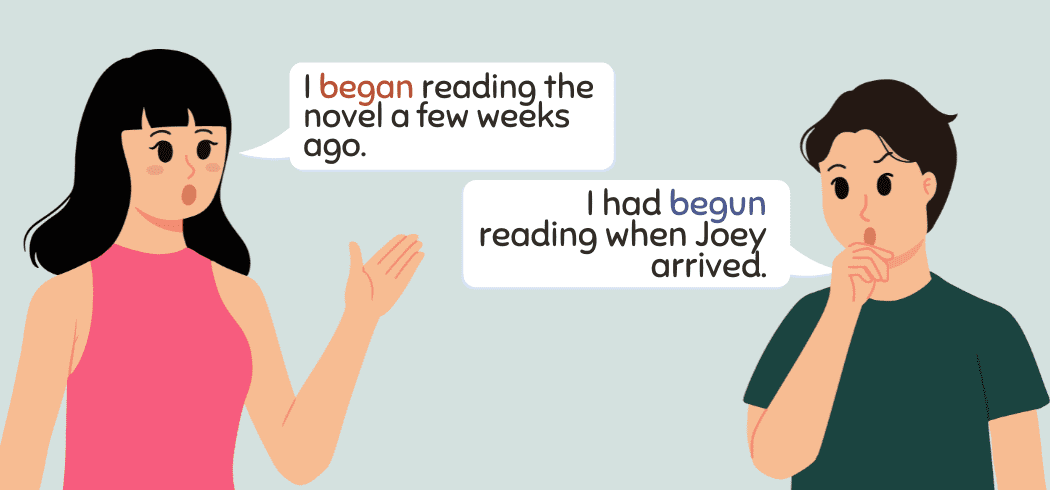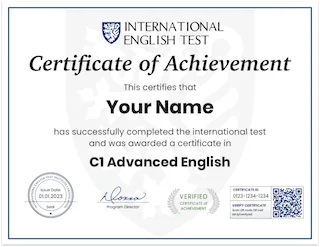Understand differences and uses “began” and “begun,” and receive expert advice on their proper utilization in sentences.
Navigating English grammar can be challenging, and a common source of confusion for learners lies in distinguishing when to employ “began” versus “begun.” Both these verb forms stem from the base verb “begin,” but they carry distinct meanings and applications. Incorrect usage can impact effective communication.
This article delves into a comprehensive examination of each verb form, offering precise definitions, comparisons, and examples to enhance your proficiency in using both forms accurately.
What is your English level?
Find out your A1 A2 B1 B2 C1 C2 level of English with our quick, free online test.
Understanding verb tenses
A significant distinction between “began” and “begun” lies in their tenses. Before delving into the specifics of each, let’s first establish the definition of verb tense and identify the specific tenses under consideration.
Simple past tense
The past simple tense is employed to portray a concluded action or event that took place in the past. Typically, it is created by appending “–ed” to regular verbs or adopting the irregular verb form.
For instance, the past simple tense of the regular verb “talk” is “talked,” while the past simple tense of the irregular verb “go” is “went.”
Since “begin” is an irregular verb, its past simple tense is “began.”
Past participle tense
In the English language, the past participle is the specific verb form utilized for constructing perfect tenses. Perfect tenses delineate actions that took place before other actions in the past (past perfect), actions that commenced in the past and continue into the present (present perfect tense), or actions that will commence before another action in the future (future perfect tense). This article will concentrate on the past perfect and present perfect tenses.
The perfect tenses are shaped by combining the past participle with an auxiliary verb such as “has,” “had,” or “have.”
Similar to the formation of the simple past tense, the past participle is created by appending “ed” to the end of regular verbs or by adopting the irregular verb form. For instance, the past participle of “talk” is “talked,” while the past participle of “go” is “gone.”
In the case of “begin,” its past participle is “begun.”

When to use began
Now that you have a grasp of the pertinent verb tenses, let’s delve into the situations in which we employ the verb form “began.”
Simple past tense
“Began” serves as the past simple tense of the verb “begin.” This tense is employed when referring to an action that commenced and concluded in the past.
For instance: The movie started promptly at 7:00 PM and concluded at 9:30 PM.
Example sentences
Here are additional instances of the past simple tense:
- We began our hike at sunrise.
- The teacher began the class by introducing the topic.
- I began learning to play the guitar when I was a child.
Tips for identifying when to use began
1. Utilize “began” when narrating an action or event that both commenced and concluded in the past, employing the simple past tense.
Example: “She initiated her presentation with an introduction.”
2. Examine the context and timeframe to discern whether the action is a completed past event or an ongoing one. If it’s a simple past occurrence that has concluded, opt for “began.”
Example: “They commenced their journey early in the morning.”

When to use begun
Having understood the instances for employing “began,” let’s now explore the verb form “begun.”
Definition
“Begun” functions as the past participle of the verb “begin,” and it is employed alongside auxiliary verbs such as “has,” “have,” or “had” to construct perfect tenses or passive verb structures.
Now, let’s explore a more in-depth analysis of the present perfect tense, past perfect tense, and passive constructions.
Present perfect tense
“Begun” can be employed in conjunction with the auxiliary verbs “has” or “have” to establish the present perfect tense. This tense is utilized when portraying actions that commenced in the past and persist into the present.
For example:
- He has begun the interview for the upcoming project.
- They have begun their research.
Past perfect tense
The past perfect tense is applied when describing an action that initiated and concluded in the past before another past event. To construct this tense, we combine “begun” with the auxiliary verb “had.”
For example:
- By the time she arrived, the meeting had already begun.
Passive verb construction
Passive verb construction is a grammatical framework wherein the action of the verb is received by the subject of the sentence rather than being performed by it. The passive voice is created by employing a form of the auxiliary verb “be” (be, am, is, are, were, was, being, been) followed by the past participle of the main verb.
Since “begun” is the past participle of “begin,” it is employed in passive verb constructions.
For example:
- Sandra began the work. (simple past tense)
- The work was begun by Sandra. (passive verb construction)
In the second sentence, the subject “Sandra” became the receiver of the action.
Example sentences
- The movie has begun. (present perfect tense)
- By the time I arrived, the party had already begun. (past perfect tense)
- The novel was begun many years ago. (passive verb construction)
- A new chapter has been begun in the company’s history. (passive verb construction)
- The race had begun before the rain started. (past perfect tense)
- The construction work had been begun by a renowned architect. (passive verb construction)
Tips for identifying when to use begun
- Employ “begun” alongside an auxiliary verb when describing an action that initiated in the past and is still ongoing (present perfect) or commenced and concluded in the past before another past event (past perfect). Take note of auxiliary verbs like “have/has/had” or “be/was/were.” In the presence of these auxiliary verbs, utilize the past participle form “begun.” Additionally, remember to incorporate “begun” when constructing passive constructions.
Common mistakes and misconceptions when using began and begun
Using “began” instead of “begun”
Some people also use “begun” when they should have used “began.”
Incorrect: She has begun her presentation yesterday.
Correct: She began her presentation yesterday.
Leaving out the auxiliary verb
Combine the past participle “begun” with an auxiliary verb (e.g., have, has, had). Failing to do so or using the wrong auxiliary verb will result in grammatically incorrect sentences.
Incorrect: They begun their vacation.
Correct: They have begun their vacation.
Overusing the present perfect tense
Another prevalent error occurs when “has/have begun” is employed instead of the more fitting simple past tense “began.”
Incorrect: She has begun her journey yesterday.
Correct: She began her journey yesterday.
Forming passive constructions incorrectly
In passive voice constructions, the past participle “begun” is employed to signify that the action was carried out on the subject. However, a common error is to substitute “began” instead.
Avoiding “began” when describing all actions or events in the past
A widespread misunderstanding is the belief that the past participle “begun” should be applied to all past actions or events. However, this is not accurate; “began” is the suitable form for narrating simple past actions that commenced and concluded at a specific time.
Are you C1 Advanced English?
Get your C1 Advanced English certificate now!
✓ Add your certificate to your resume
⭐ ⭐ ⭐ ⭐ ⭐
Comparing when to use began vs. begun
While both “began” and “begun” serve as past forms of the verb “begin,” they possess distinct applications and contexts within English grammar. We’ve touched on some of the variances earlier, but let’s examine the comparisons with a bit more depth.
Key differences
Context:
-
“Began” is the simple past tense manifestation of “begin,” employed for narrating actions or events that commenced and concluded in the past.
-
“Begun” is the past participle form of “begin.” It is utilized to create the present perfect tense (for an ongoing action that initiated in the past), the past perfect tense (for an action that both commenced and concluded in the past), and in passive constructions.
Auxiliary verbs:
- “Began” doesn’t need an auxiliary verb.
- “Begun” is used with auxiliary verbs to form perfect tenses or as part of passive verb constructions.
Example sentences with began
Simple past tense
- She began her presentation with an introduction.
- They began their journey early in the morning.

Conclusion
Utilizing the correct verb forms is essential for refining your English language skills and accurately conveying your intended meaning. While navigating the differences between “began” and “begun” may be perplexing, the insights shared in this guide serve as helpful aids in understanding their usage.
We clarified that “began” is the simple past tense of “begin,” applicable for recounting actions that transpired in the past. On the other hand, “begun” is the past participle form, used with an auxiliary verb to delineate an ongoing or completed action that commenced in the past. Additionally, it finds application in passive constructions.
What is your English level?
Find out your A1 A2 B1 B2 C1 C2 level of English with our quick, free online test.





